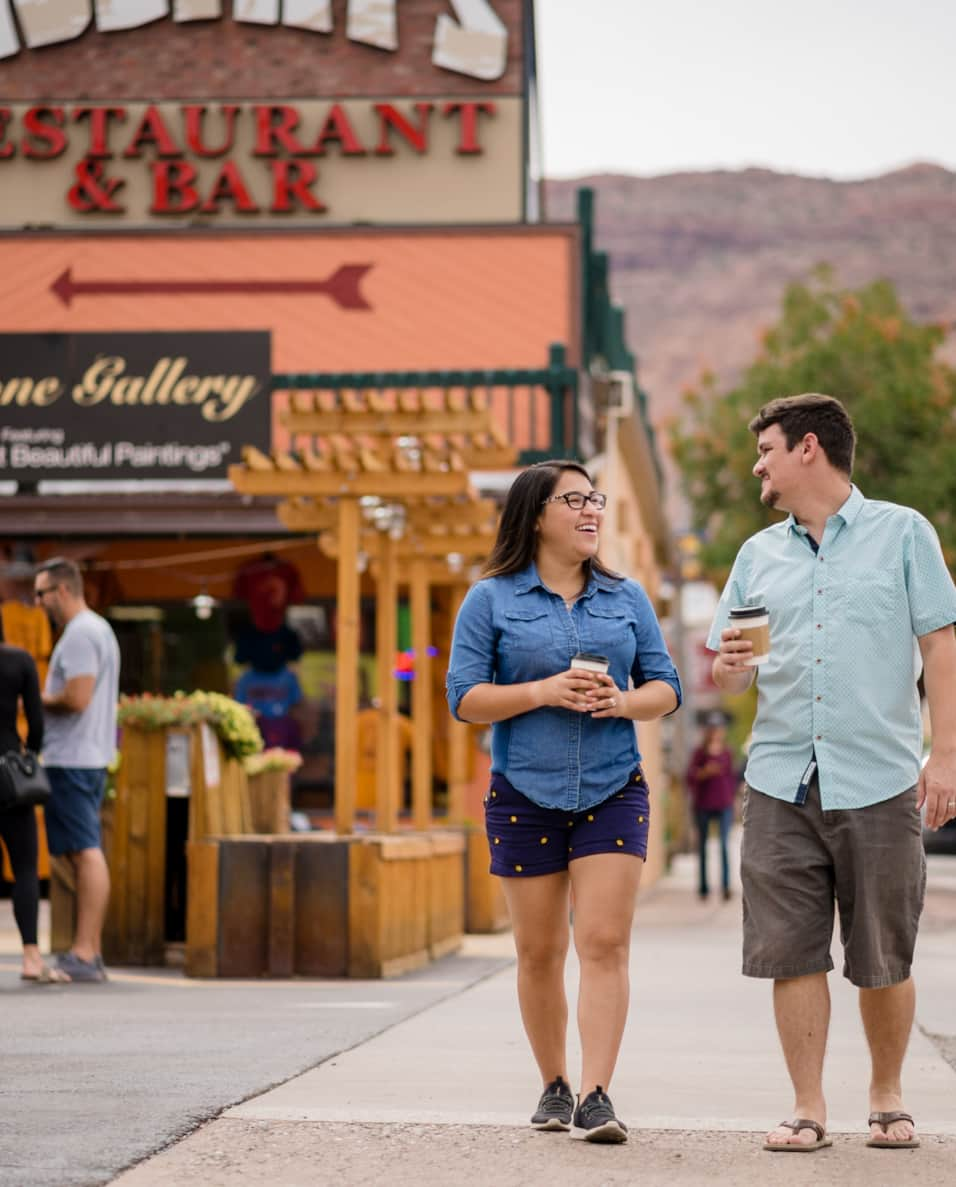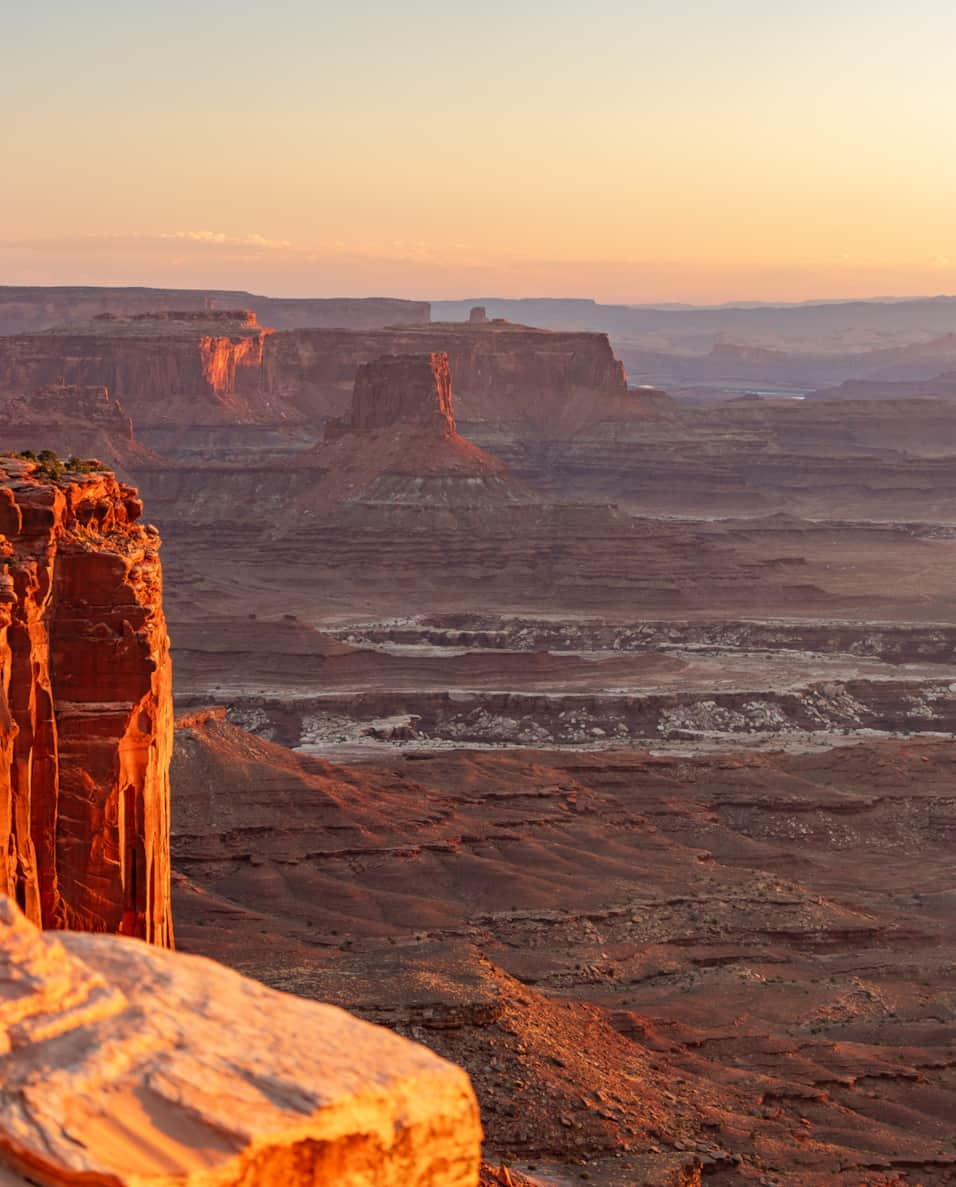Outdoor Recreation In Moab
-

Mountain Biking
With hundreds of trails to cover, you’ll have more than enough Moab riding to keep you coming back year after year. The Whole Enchilada (which includes the Porcupine Rim section), Slickrock Trail and Captain Ahab have been named best trails by Singletracks, Outside and Trailforks. With that said, mountain biking here is generally difficult. The rolling slickrock pairs excellent traction with punchy small climbs. Most trails have some degree of technical terrain and soft, sandy stretches are common. Luckily, the town is passionate about riding and there are a handful of locally-owned bike shops where you can rent gear and get local tips for a safe ride. Local groups have been building trails for all rider ability levels to complement the more technical trails, so everyone can enjoy unforgettable mountain biking in Moab.
-

Hiking
With trails leading to some of the world’s most recognized natural landmarks like Delicate Arch and Colorado River’s Gooseneck, it’s hard to ignore the allure of hiking in Moab. Some of the most popular hiking trails are paved and easily accessible, but you’ll want to bring your hiking boots for some slickrock scrambling once you’re off the beaten path. First-time hikers should visit Delicate Arch, Corona Arch and Grandstaff Trail to see some of Moab’s highlights. Hidden Valley Trail, Fisher Towers Trail and Hunter Canyon Trail are great options for hikers seeking solitude. A tip for hiking in Moab — expect the weather and terrain to be more taxing than most other areas. Pack at least two liters of water per person, sun protection and a map of the area to keep you on track.
-

Climbing & Canyoneering
In 1962, Layton Kor, Huntley Ingalls and George Hurley made history with the first ascent up The Finger of Fate route on Titan Tower, the most prominent of the Fisher Towers and the tallest natural sandstone tower in North America. Their success intrigued climbers around the world, and the rest is history. Today, experienced climbers and canyoneers travel to Moab for a chance to top out on the region’s sandstone formations or feel the rush of rappelling and scrambling down a canyon. Wall Street and Longbow Arch are popular destinations, but the best way to climb or canyoneer in Moab is with a guide who keeps you safe and shares stories about the area’s history.
-

Photography & Dark Skies
Photographers travel from all over the world to take shots of Moab’s open spaces. In fact, Dead Horse Point Scenic Overlook is credited as one of the most photographed scenic vistas in the world. However, once the sun sets and the desert darkens, you’ll want to keep your camera ready. Moab is home to some of the darkest night skies anywhere in the world. For many people, this may be the best view of the stars they’ve ever seen. So set up a lawn chair, turn down the lights and take a look upward for a chance to reconnect with the stars.
-

Camping
It’s hard to match the feeling of falling asleep beneath pitch black night skies, then waking with the sun as its rising light illuminates the Entrada and Navajo Sandstone. Tent campers can find sites in the parks, at established campgrounds just outside of town or dispersed throughout the region’s BLM land. Plus, Moab has an excellent selection of camping resorts, from RV parks to the luxurious Under Canvas Moab glamping resort. Sites at popular campgrounds can be reserved months ahead of time, so find your campground early and plan your trip during the week or off peak-season to avoid the crowds.
-

Rafting
Just southwest of Moab, where the Green River meets the Colorado, lies the biggest whitewater section in North America, Cataract Canyon. This stretch of the Colorado River in Canyonlands National Park should be on every white water rafter’s bucket list. Here, the most adventurous among us can expect to barrel through huge whitewater rapids beneath commanding red rock formations. Not quite ready to commit to a multi-day rafting trip in the rapids? The Moab Daily and nearby Green River Daily stretches offer much more inviting water and an opportunity to spend a day soaking up beautiful views of the red cliff walls and even see a mountain goat or two.
-

Horseback Riding
Experience the majesty of the Moab desert on a horseback or mule ride. Take in miles of scenic open range as you wander along the Colorado River, ride backcountry trails or visit famous movie sites on a trip tailored to your experience level. Touring this unchanged, stunning landscape on horseback is like stepping back in time.
-

Scenic Drives
Although this is Utah’s adventure epicenter, it’s not all about adrenaline-pumping adventures. The drive into Moab is the first of many opportunities to see the gorgeous vistas from behind the wheel. Spend an early morning driving through Arches National Park, where a single road winds through some of the park’s most magnificent landmarks. Or, ramble down the La Sal Mountain Loop Road where the arid desert landscape meets high alpine pinyon and juniper tree forests. Give yourself an afternoon and take this drive during the fall months to see the fall leaves changing.
Moab Guides, Tours and Rentals
-
4x4 Tours
Shaped by millions of years of erosion, Moab’s sea of slickrock offers a seemingly endless list of trails and obstacles for Jeeps, Hummers and other four-wheel rigs. This is the home of Easter Jeep Safari, a nine-day event where off-roaders travel around the U.S. to crawl over Moab’s rugged terrain. If you’re feeling hesitant about subjecting yourself and your SUV to this kind of abuse, don’t worry. Fully capable rentals and guided tours are available in town to help you feel the rush of creeping down a 50-degree rock face. A few of Moab’s most popular 4x4 routes are Fins and Things and Hell’s Revenge, both of which can be experienced with a local guide.
-
Helicopter Tours
Get a birds-eye view of Moab’s buttes, arches, canyons and more with a helicopter tour. Pinnacle Helicopters offers tours of Canyonlands, backcountry arches and Happy Canyon. There are also photography-focused “doors off” tours that can be customized based on the type of shots you want to get.
-
Hot Air Ballooning
See Arches National Park, Canyonlands National Park, Dead Horse Point and other famous landmarks at sunrise, all from the unique perspective of a hot air balloon! These tours are offered through Red Rock Ballooning and Moab Adventure Center and are available between March and October.
-
Motorcycle Tours and Rentals
Whether you want to rent a bike and explore on your own or take a guided tour, a motorcycle ride is a fun, adrenaline-filled way to take in the sights of Moab. Popular rides include Dead Horse Point Mesa Scenic Byway, Highway 313, Upper Colorado River Scenic Byway and Arches National Park.
-
Ride the Moab Zipline
Take a thrilling ride over sandstone cliffs and canyons on the Raven’s Rim Moab zipline tour. This exciting experience starts with a 4x4 ride to the top of the cliff faces that overlook Moab. After a quick orientation, you’ll zip to the 100-foot suspension bridge and that’s where the journey really starts. This zipline tour features six steel cables that will take you across canyons, natural fins and gaps for over two hours.
-
Skydiving
Want to check an item off your bucket list? Skydiving in Moab is an adrenaline-packed way to see the sights from a unique perspective. It’s understandable to be a little nervous about taking the leap, but for companies like Skydive Moab, safety is the number one priority. Skydive Moab has led over 35,000 safe and successful skydiving trips and has hundreds of great reviews on TripAdvisor. So if you’ve been thinking about skydiving for a while, a trip to Moab is the perfect opportunity to finally do it!




































